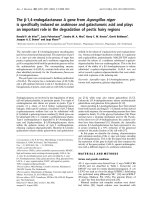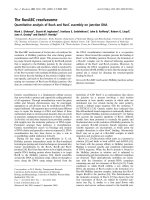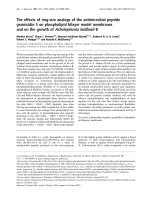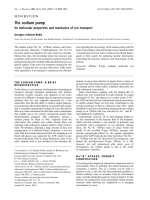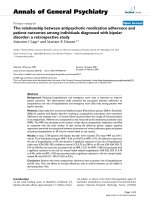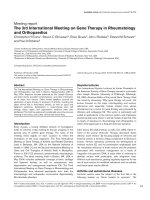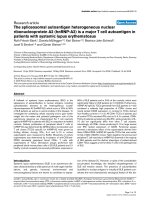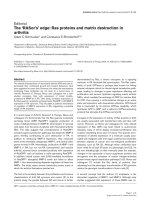Báo cáo y học: "The International Symposium on Intensive Care and Emergency Medicine continues to grow every year, with in excess of 4000 attendees. With six parallel sessions for four frenetic days, it covers all" doc
Bạn đang xem bản rút gọn của tài liệu. Xem và tải ngay bản đầy đủ của tài liệu tại đây (60.22 KB, 7 trang )
ALI/ARDS = acute lung injury/acute respiratory distress syndrome; CV = conventional ventilation; HFV = high-frequency ventilation; ICU = intensive
care unit; NIV = noninvasive ventilation; PEEP = positive end-expiratory pressure; RBC = red blood cell; RRT = renal replacement therapy.
Critical Care June 2002 Vol 6 No 3 Ball et al.
The International Symposium on Intensive Care and
Emergency Medicine continues to grow every year, with in
excess of 4000 attendees. With six parallel sessions for four
frenetic days, it covers all aspects of critical care from a
variety of perspectives. This year, as in previous years, the
symposium was marred only by the perennial problems of
overcrowding and audiovisual glitches. The organisers, to
their credit, had attempted to counter the problems with use
of lecture rooms beyond the congress centre. Sadly,
however, many sessions remained oversubscribed. Web
casting of lectures to second venues has successfully been
employed elsewhere and would greatly enhance this, already
pre-eminent, international critical care symposium.
Opening session
As is traditional, the exuberant and charismatic Jean Louis
Vincent (Brussels, Belgium) opened this year’s meeting,
espousing ‘The great step forward’. His personal tour
through the events of the past 12 months focused on the first
Hippocratic tenet: ‘first, do no harm’. Iatrogenic injury was his
major theme, be it by the use of excessive tidal volume [1],
excessive sedation [2,3], delayed resuscitation [4], poor
glycaemic control [5], inadequate renal replacement [6], or
failure to cool the brain post anoxic injury [7,8]. He went on,
however, to caution against the vagaries of fashion. Despite
negative studies, he argued, there is still a place for the
pulmonary artery catheter [9], for albumin [10,11] and for
dopamine [12], but their use must be intelligently tempered.
Two items of breaking news were also raised. First, the
recent sepsis consensus conference may shortly result in the
abandonment of the Systemic Inflammatory Response
Syndrome (SIRS) criteria in favour of PIRO [13] (see also
[14]). Second, participation in the up and coming Sepsis
Occurrence in the Acutely Ill Patient (SOAP) study
(1–15 May 2002) was promoted to all participants.
Jean Carlet (Paris, France) and Derek Angus (Pittsburgh, PA,
USA) then presented a report from the presymposium round-
table conference, ‘Surviving intensive care’. To date, the vast
majority of intensive care unit (ICU) interventional studies
have used short-term morbidity and mortality as outcome
measures. However, there is an increasing desire and
necessity to establish the long-term outcomes. What little
evidence does exist suggests that survivors of critical illness
have diminished life expectancy, functional limitations,
neuropsychological morbidity and, unsurprisingly, a reduced
quality of life [15–20]. The round-table group reached the
following conclusions:
• Established and evolving best practice has identified, and
will continue to identify pre, intra and post ICU causes
and modifiers of a poor long-term outcome. In particular,
preventing neuro-musculo-skeletal sequelae by ensuring
early and successful feeding, coupled with a proactive
approach to physiotherapy and rehabilitation, is essential.
• Historical precedents should remind us that good short-
term outcomes can result in poor long-term outcomes
(e.g. milrinone in the treatment of chronic congestive
cardiac failure). Long-term follow up as routine practice in
all interventional trials is thus to be encouraged and
should have a place in everyday practice. However, this is
almost certainly beyond the scope of intensivists, hence
creative partnerships between ICUs, referring and primary
care clinicians need to be forged.
Meeting report
22nd International Symposium on Intensive Care and Emergency
Medicine, Brussels, Belgium, 19–22 March 2002
Jonathan Ball
1
, Richard Venn
2
, Gareth Williams
3
and Lui Forni
4
1
Lecturer in Intensive Care Medicine, Department of Anaesthesia & Intensive Care, St George’s Hospital Medical School, University of London, UK
2
Consultant in Anaesthesia and Intensive Care, Worthing Hospital, UK
3
Clinical Research Fellow, Intensive Therapy Unit, St George’s Hospital, London, UK
4
Consultant in Renal Medicine and Intensive Care, Worthing Hospital, UK
Correspondence: Jonathan Ball,
Published online: 30 April 2002 Critical Care 2002, 6:264-270
© 2002 BioMed Central Ltd (Print ISSN 1364-8535; Online ISSN 1466-609X)
Available online />Jean Mira (Paris, France) gave a whirlwind tour through the
topic of genetic predisposition as it genuinely begins to
impact at the bedside. Polymorphisms in both the promoters
and the coding regions of specific genes, affecting the
quantity and quality, respectively, of the gene product, have
now been identified that confer a quantifiable risk of disease
severity and fatal outcome in critical illness [21–27]. With the
rapid and dramatic advances in nanochip and microarray
technology, bedside genotyping is set to become a reality
over the next few years [28]. This raises the possibility of
designing specific therapeutic cocktails to counter the
susceptibilities identified by genotyping. However,
enthusiasm for this science fiction approach must be
tempered by the enormous gulf between identifying
genotypic risk and successful development of therapeutic
interventions. The even thornier issues of the socioeconomic
ramifications of genotype profiling need legislative
consideration now if the worst elements of eugenic prejudice
are to be avoided.
Steven Opal (Pawtucket, RI, USA) gave an overview of the
complex integration between dysregulation of the innate
immune and coagulation systems [29]. Although a number of
recent discoveries have illuminated this field, it appears to
have been around for at least 800 million years [30]! The
relevance of this subject relates to the success of
recombinant human activated protein C in severe sepsis [31]
in contrast to the failure of antithrombin III [32].
Greet Van den Berghe (Leuven, Belgium) presented results
from the landmark intensive insulin study [5]. She reminded the
audience that although the renal glucose threshold is in the
order of 12 mmol/l, other tissues (in particular, the lung) might
exhibit thresholds as low as 8 mmol/l. The intensive group in
this study demonstrated not only a much lower incidence of
multiorgan failure and nosocomial infection, but demonstrated
decreased polyneuropathy and mortality. Whether this is the
effect of higher doses of insulin or lower levels of blood
glucose remains speculative. What is clear is that high insulin
requirements are associated with a worse prognosis. This
study also serves to demonstrate the vital importance of
attending to routine care, as this can achieve benefits equal to
or greater than novel therapies, and at a fraction of the cost.
Peter Andrews (Edinburgh, UK) presented the evidence for,
and mechanisms by which, isolated brain cooling can be
achieved [33]. This work may help explain the contradictory
results from trials of systemic cooling following neurological
injury [7,8,34,35].
The final two lectures in this session covered the issues of
terrorist attacks and mass casualty response. The lessons
learned from recent and ongoing world events are that
education, preparedness and practice [36] are the vital
elements in meeting the harrowing challenges presented by
such events.
Early haemodynamic stabilisation
In this enthusiastically attended session, chaired by
Christopher Doig (Calgary, Canada) and Daniel De Backer
(Brussels, Belgium), some of the more practical issues
concerning the care of the haemodynamically unstable
patient were discussed.
Jesse Hall (Chicago, IL, USA) opened the session stressing
that by the bedside, as yet, we are only able to assess global
oxygen delivery and consumption and to monitor surrogates
of tissue hypoxia. We presently have no direct means of
assessing tissue perfusion, let alone specific vascular beds.
However, Jesse Hall questioned the practice of oxygen
delivery/consumption goal-directed therapy in the critically ill
patient, citing a number of papers demonstrating
disappointing or adverse outcomes [37–39].
In firm and eloquent rebuttal to this, Robert Grounds
(London, UK) presented the evidence for goal-directed
therapy, particularly with respect to the high-risk surgical
patient. He suggested that there is now an increasingly
convincing body of evidence to support the practice of
preoperative ‘optimisation’ in the form of fluid and inotropic
manipulation of the circulation to improve cardiac output and,
hence, tissue oxygen delivery. A number of studies over the
past decade have shown impressive reductions in
postoperative mortality by employing this technique [40–43].
It was a treat to hear a landmark paper presented by its first,
now famous author, Emmanuel Rivers (Detroit, MI, USA) [4].
In studying a group (n = 263) of patients admitted to the
emergency room with severe sepsis and septic shock,
subjects were randomised to either early goal-directed
therapy (treatment group) or standard therapy (control). They
used traditional resuscitation end points, blood pressure,
central venous pressure and urine output, as well as central
venous saturation, to target therapy. Results were striking, to
say the least, with 60-day mortality of 44.3% and 56.9% in
the treatment and control groups, respectively. Food for
thought that 6 hours of simple resuscitation, if prompt, can
have such an impact on the mortality rate in severe sepsis
without recourse to novel and massively expensive
pharmacological strategies.
Finally in this session, Konrad Reinhart (Jena, Germany)
reminded us of the potential use of central venous
saturations as a guide to therapy, thereby possibly avoiding
the need for pulmonary artery catheterisation [44].
Noninvasive mechanical ventilation
The session on noninvasive ventilation (NIV) proved popular. It
summarised the research in this field, discussed various
practical problems and suggested remedies. Umberto Meduri
(Memphis, TN, USA) divided the evidence for NIV in acute
respiratory failure on the basis of timing into early (to prevent
intubation), established (as an alternative to intubation),
Critical Care June 2002 Vol 6 No 3 Ball et al.
resolving (to wean from mechanical ventilation), and
postextubation (to prevent reintubation). Overall, the eight
randomised studies for patients with chronic obstructive
pulmonary disease showed significant reductions in intubation
requirements and mortality, when used early. The evidence for
early intervention in patients without chronic obstructive
pulmonary disease and in the remaining time frames suggested
favourable outcomes, but more studies are required.
An analysis of the need for intubation following NIV showed
that mask intolerance resulted in 11% of cases [45]. Paolo
Navalesi (Pavia, Italy) reiterated that faces are all different and
there was therefore a need for a wide variety of facemasks
for the individual to try, if NIV was to be successful.
The problem of gas leaks was discussed by Robert
Kacmarek (Boston, MA, USA), and the mannequin model of
Schettino and colleagues [46] highlighted the fact that
inappropriately high pressure support can greatly exacerbate
leaks. To prevent rebreathing, Robert Kacmarek stressed the
need for adequate positive end-expiratory pressure and that
the exhalation port should be ideally placed in the facemask
[47]. Laurent Brochard (Creteil, France) continued on the
subject of leaks and suggested the use of ventilators, which
are capable of monitoring inspiratory and expiratory tidal
volumes early in acute respiratory failure, to identify
insufficient ventilation as a consequence of leaks.
Asynchrony as a result of leaks may be aided by the use of
time-cycled ventilation, although this will obviously not
resolve any leaks. Finally, the addition of helium to NIV may
reduce the work of breathing, although limited space may
prevent placement of the large tanks of helium required, and
only certain ventilators are able to work with helium.
Massimo Antonelli (Rome, Italy) reviewed the trials for the use
of NIV in acute lung injury/acute respiratory distress
syndrome (ALI/ARDS). He concluded that the present
favourable evidence should not be interpreted to support the
extensive use of NIV in ALI/ARDS, but rather it should be
used to design a randomised, controlled trial for NIV early in
ALI/ARDS.
Finally, Phillipe Jolliet (Geneva, Switzerland) concluded that
there was no solid evidence to support the use of NIV in
community acquired pneumonia except in the subgroups of
patients with chronic obstructive pulmonary disease and in
the immunosuppressed. In all groups, however, NIV improves
blood gases in community acquired pneumonia, NIV does not
increase nursing workload in experienced units, no adverse
effects have been demonstrated and, importantly, intubation
is not delayed since it occurs early in community acquired
pneumonia if required.
PEEP recruitment: do we understand it?
An afternoon was devoted to answering this question and,
consequently, there was a good deal of overlap between
speakers. All agreed that recruitment was necessary to
establish alveolar patency in all recruitable lung zones and to
therefore avoid repeated opening/closing of lung units with
consequent inflammation and lung injury.
Jordi Mancebo (Barcelona, Spain) highlighted that
recruitment is a time-dependent process, and that
approximately 40 s is required during a sustained high-
pressure (P
max
=40cmH
2
O) recruitment manoeuvre. Other
recruitment manoeuvres include sighs, progressive PEEP
(with fixed peak pressure and tidal volume), and repositioning
(e.g. prone position, lateral position), although how PEEP is
best selected following recruitment is not known. Biological
variable ventilation (i.e. varying tidal volume as would happen
physiologically) is an interesting new concept. It has been
shown to improve recruitment and to reduce interleukin-6
levels, and therefore may reduce lung injury. Prof. Kacmarek
(Boston, MA, USA) summarised that pressure/volume curve
analysis is no longer considered clinically useful in
determining best PEEP since methodology has not been
standardised for curve derivation, and the upper inflection
point and point of maximum curvature may be affected by
different methodologies.
Fernando Suarez (Madrid, Spain) gave a very clear
presentation of his work investigating oxygenation (PaO
2
/FiO
2
ratios) versus lung mechanics (static compliance) in
identifying best PEEP. Using a decremental PEEP trial (i.e.
following recruitment), oxygenation and compliance were
improved in comparison with an incremental PEEP trial (i.e.
prior to recruitment), although optimal positions for
oxygenation and compliance were at different positions on
this curve. We are consequently none the wiser at predicting
the point to set PEEP where lung overdistension and lung
collapse are at a minimum. The moderators (Michael Pinsky,
Pittsburgh, PA, USA, and Antonio Pesenti, Monza, Italy)
commented that PaO
2
/FiO
2
ratios may not be the best
measure of shunt since PEEP can cause ventricular
dysfunction, which affects shunt. Finally, Laurent Brochard
(Creteil, France) discussed the influence of tidal volume on
alveolar recruitment [48], and suggested that PEEP may need
to be increased if using protective low tidal volume ventilation.
Although this session left the audience none the wiser in
clinically determining best PEEP, the evidence to date
suggests that the lung should be kept open to prevent
ventilator-induced lung injury, although to achieve this we
may be simultaneously subjecting the lung to overdistension
and ventilator-induced lung injury. Finally, it was commented
that the NIH PEEP trial had recently been abandoned since
initial analysis had shown no effect, and because subsequent
power analysis had revealed that the numbers of patients
therefore required to show an effect would be massive.
Perhaps the high PEEP was not applied appropriately since
the method of recruitment in the decremental PEEP trial was
not used in this study.
High-frequency ventilation: pro/con debate
A very amusing debate followed, with Arthur Slutsky
(Toronto, Canada) directing his attack at ridiculing Robert
Kacmarek (Boston, MA, USA) with the use of surreptitiously
obtained holiday photographs of the latter, to remove his
credibility as a speaker! This left Arthur Slutsky with very little
time to discuss the evidence that high-frequency ventilation
(HFV) is beneficial.
Robert Kacmarek led a strong defence and showed that
animal studies comparing HFV with conventional ventilation
(CV) had utilised a nonprotective lung strategy in the CV arm,
and so comparison was not valid. Similarly, human data from
the second multicentre oscillatory ARDS trial (MOAT II)
showed a trend towards a reduction in mortality at 90 days,
although the study was not powered to investigate this.
However, the CV group in this trial received mean tidal
volumes of 10.2 ml/kg, which more recent evidence [1]
suggests is too large and hence detrimental.
Following the debate, both speakers agreed that HFV and
CV are equally efficacious, although HFV should theoretically
be superior. The benefits seen in the neonatal ICU (although
the incidence of intraventricular haemorrhage was higher in
this particular HFV population when compared with CV) may
be the result of being able to use higher frequencies
compared with adults. In the adult ICU, HFV frequencies are
halved to enable adequate carbon dioxide clearance.
Renal failure
A broad range of subjects relating to renal failure were
touched on, and the usual questions when considering renal
failure in the critically ill (namely choice of renal replacement
therapy [RRT] modality, type of membrane and adequacy)
were raised.
Daniel Traber (Galveston, TX, USA) entertained us with an
overview of the kidney’s response to sepsis, which led us
into the debate regarding modality. The overall consensus
seemed to be in favour of continuous treatments, although no
major antagonists were present: perhaps the battle has been
won. As John Kellum (Pittsburgh, PA, USA) pointed out: are
continuous therapies better? Probably!
There were the usual statistics with regard to mortality of
acute renal failure. It is important to remember, however, that
single-organ acute renal failure carries a mortality < 8%. The
≥ 50% mortality reflects the overall picture of multiorgan
failure of which acute renal failure is a part.
Kurt Lenz (Linz, Austria) discussed the hepatorenal syndrome
and cemented the view that this remains a diagnosis of
exclusion. Finally, Claudio Ronco (Vicenza, Italy) outlined the
concept, beloved to nephrologists, of adequacy. It was one
of the few times I have heard K
t
/V (the RRT clearance of
urea, in other words a measure of the adequacy of RRT [49])
discussed outside a renal ward, and it perhaps may have
helped clear up some misconceptions with regard to RRT.
Ronco also gave an excellent plenary lecture on
extracorporeal support in sepsis, although unfortunately the
jury remains out on this treatment. As he said: until the
randomised, controlled trial is carried out, we will not know.
Acid–base
David Bennett’s (London, UK) honesty must be commended
in suggesting that strong ion difference and strong ion gap
are difficult to comprehend. In fact, his explanation of the
subject was extremely clear. Recent work at his hospital had
unfortunately not found strong ion difference a useful
prognostic marker for patients admitted to the ICU.
John Kellum (Pittsburgh, PA, USA) showed that acidosis
worsens shock in an animal model, and that acidosis is
proinflammatory in cultured lung macrophages. The
implication is therefore that, under most conditions, acidosis
should be avoided in the critically ill. This does not
necessarily, however, imply that mild acidosis requires
correction with sodium bicarbonate, not least as the
controversies surrounding this intervention remain [50].
Head trauma
Andrew Maas (Rotterdam, The Netherlands) discussed the
pros and cons of using cerebral perfusion pressure, blood
flow or oxygen to target therapy in the management of head
trauma. Oxygen-targeted therapy using jugular venous
oxygen saturation monitoring was appealing, although this
has not yet been validated. Other treatment modalities
presented by other speakers (e.g. raising cerebral perfusion
pressure, hypothermia) have unfortunately continued to show
disappointing results in the management of head trauma.
Andrew Maas ended the session, however, by explaining that
these treatments may in fact be beneficial but the outcome
assessments were invalid. In many of these trials, the
Glasgow Outcome Scale was used and outcome was
dichotomised into good/poor, when in fact this is a four-point
scale. If reanalysed using a sliding-dichotomised method, as
previously used in many of the stroke trials, then many of the
head trauma studies were grossly under-powered.
Transfusion
This excellent session covered all aspects of the increasingly
muddy waters surrounding the issues of red cell transfusion
in resuscitation and critical illness. With the landmark
Canadian study of restricted transfusions in critically patients
[51], the possibility of disease transmission (in particular,
new-variant Creutzfeldt-Jacob Disease) and the simple
economics of demand outstripping supply, the questions
regarding what you should transfuse and when it should be
transfused have escalated.
The effects of storage on red blood cell (RBC) deformability
and oxygen dissociation are well established [52–55]. What
Available online />happens to such cells once in the circulation remains more
contentious. Timothy Walsh (Edinburgh, UK) presented the
preliminary results of a study in which the haemoglobin
concentration of critically ill patients was closely monitored
peritransfusion. His group found that the haemoglobin
concentration returned to baseline (transfusion threshold)
within 48 hours. Further investigations suggest that, despite
this and the gross morphological abnormalities of the stored
RBCs, these cells persist in the circulation well beyond this
48-hour period. He stressed that the haemoglobin
concentration and RBC mass do not have a linear
relationship, especially in critically ill patients who tend to
exhibit low mean corpuscular haemoglobin concentration.
Timothy Walsh concluded by reminding the audience that the
risk–benefit profile of top-up transfusion has yet to
established.
The immunosuppressive effects of allogenic RBC transfusion
are well established [56,57]. One of the major contributors is
thought to be the presence of allogenic leukocytes. Indeed,
the positive findings of the Canadian restricted transfusion
study [51] have been attributed, at least in part, to the
reduced dose of allogenic leukocytes in the restricted group.
Hence the widespread interest in investigating the effects of
universal leukocyte depletion. Such a strategy appears to
have benefits, although these may depend on whether the
removal is performed prestorage or pretransfusion [58]. Jean-
François Baron (Paris, France) presented the results of the
recently published French study, which investigated the
incidence of postoperative infections in patients undergoing
abdominal aortic aneurysm repair who received
leukodepleted or nonleukodepleted blood transfusions [59].
Although no statistically significant different was found
between the two groups, the study was grossly
underpowered. The results of a larger Canadian study are
keenly awaited.
Alternative strategies to packed RBC transfusion were also
discussed. Howard Corwin (Lebanon, USA) presented the
case for routine use of recombinant erythropoietin [60,61]. In
essence, the evidence to date demonstrates that
erythropoietin significantly reduces transfusion requirements
but has failed to show a morbidity or mortality benefit.
Intriguingly, erythropoietin appears to have extensive
neuroprotective properties, and human trials in a variety of
acute neurological insults are eagerly awaited [62].
Marcos Intraglietta (La Jolla, CA, USA) presented an
emerging alternative hypothesis to the dogma of maintaining
oxygen delivery by maintaining oxygen carrying capacity (i.e.
RBC transfusion). He presented the evidence that
maintenance of blood viscosity and hence functional capillary
density is the critical factor [63]. He went on to present his
and others work on PEGylated haemoglobin solution, which
not only increases blood viscosity, but also is the first free
haemoglobin solution to exhibit near identical oxygen
dissociation characteristics to RBCs. PEGylated
haemoglobin solution consequently does not induce the
limiting hypertension and microvascular pathophysiology
associated with other free haemoglobin solutions [64–66].
In the context of acute, severe/unstoppable haemorrhage,
Mauricio Lynn (Miami, FL, USA) presented data that
recombinant activated factor VII offers a new life-saving
intervention [67–69]. Indeed, it seems probable that this
drug will be the subject not only of clinical studies into the
treatment of haemorrhage, but may also have a role in
immune modification as it avidly binds tissue factor.
Recombinant activated factor VII is thus being investigated
as a carrier molecule to neutralise this major proinflammatory
mediator.
Conclusion
As the preceding sections hopefully demonstrate, the breath
and depth of this year’s symposium, as in previous years, left
attendees spoilt for choice and, potentially at least,
exhausted. Undoubtedly, the International Symposium on
Intensive Care and Emergency Medicine will continue to
expand both as an educational forum and as a research
forum, creating ever greater challenges to the programme
designers.
Competing interests
None declared.
References
1. Ventilation with lower tidal volumes as compared with tradi-
tional tidal volumes for acute lung injury and the acute respi-
ratory distress syndrome. The Acute Respiratory Distress
Syndrome Network. N Engl J Med 2000, 342:1301-1308.
2. Kress JP, Pohlman AS, O’Connor MF, Hall JB: Daily interruption
of sedative infusions in critically ill patients undergoing
mechanical ventilation. N Engl J Med 2000, 342:1471-1477.
3. Brook AD, Ahrens TS, Schaiff R, Prentice D, Sherman G,
Shannon W, Kollef MH: Effect of a nursing-implemented seda-
tion protocol on the duration of mechanical ventilation. Crit
Care Med 1999, 27:2609-2615.
4. Rivers E, Nguyen B, Havstad S, Ressler J, Muzzin A, Knoblich B,
Peterson E, Tomlanovich M, and the Early Goal-Directed Therapy
Collaborative Group: Early goal-directed therapy in the treat-
ment of severe sepsis and septic shock. N Engl J Med 2001,
345:1368-1377.
5. Van den Berghe G, Wouters P, Weekers F, Verwaest C,
Bruyninckx F, Schetz M, Vlasselaers D, Ferdinande P, Lauwers P,
Bouillon R: Intensive insulin therapy in critically ill patients.
N Engl J Med 2001, 345:1359-1367.
6. Schiffl H, Lang SM, Fischer R: Daily hemodialysis and the
outcome of acute renal failure. N Engl J Med 2002, 346:305-
310.
7. Mild therapeutic hypothermia to improve the neurologic
outcome after cardiac arrest. N Engl J Med 2002, 346:549-
556.
8. Bernard SA, Gray TW, Buist MD, Jones BM, Silvester W,
Gutteridge G, Smith K: Treatment of comatose survivors of
out-of-hospital cardiac arrest with induced hypothermia.
N Engl J Med 2002, 346:557-563.
9. Connors AF Jr, Speroff T, Dawson NV, Thomas C, Harrell FE Jr,
Wagner D, Desbiens N, Goldman L, Wu AW, Califf RM, Fulker-
son WJ Jr, Vidaillet H, Broste S, Bellamy P, Lynn J, Knaus WA:
The effectiveness of right heart catheterization in the initial
care of critically ill patients. SUPPORT Investigators. JAMA
1996, 276:889-897.
Critical Care June 2002 Vol 6 No 3 Ball et al.
Available online />10. Human albumin administration in critically ill patients: sys-
tematic review of randomised controlled trials. Cochrane
Injuries Group Albumin Reviewers. BMJ 1998, 317:235-240.
11. Wilkes MM, Navickis RJ: Patient survival after human albumin
administration. A meta-analysis of randomized, controlled
trials. Ann Intern Med 2001, 135:149-164.
12. Bellomo R, Chapman M, Finfer S, Hickling K, Myburgh J: Low-
dose dopamine in patients with early renal dysfunction: a
placebo-controlled randomised trial. Australian and New
Zealand Intensive Care Society (ANZICS) clinical trials group.
Lancet 2000, 356:2139-2143.
13. Vincent JL: Reflection and reaction: sepsis definitions. Lancet
Infect Dis 2002, 2:135.
14. Ball J: Meeting report: what are the challenges of translating
positive trial results in severe sepsis into clinical practice? A
media roundtable debate, 18th March 2002, Brussels,
Belgium. Crit Care 2002, 6:271-274.
15. Jones C, Griffiths RD, Humphris G, Skirrow PM: Memory, delu-
sions, and the development of acute posttraumatic stress dis-
order-related symptoms after intensive care. Crit Care Med
2001, 29:573-580.
16. Udekwu P, Gurkin B, Oller D, Lapio L, Bourbina J: Quality of life
and functional level in elderly patients surviving surgical
intensive care. J Am Coll Surg 2001, 193:245-249.
17. Lam S, Ridley S: Critically ill medical patients, their demo-
graphics and outcome. Anaesthesia 1999, 54:845-852.
18. Davidson TA, Rubenfeld GD, Caldwell ES, Hudson LD, Steinberg
KP: The effect of acute respiratory distress syndrome on
long-term survival. Am J Respir Crit Care Med 1999, 160:1838-
1842.
19. Angus DC, Musthafa AA, Clermont G, Griffin MF, Linde-Zwirble
WT, Dremsizov TT, Pinsky MR: Quality-adjusted survival in the
first year after the acute respiratory distress syndrome. Am J
Respir Crit Care Med 2001, 163:1389-1394.
20. Brun-Buisson C: The epidemiology of the systemic inflamma-
tory response. Intensive Care Med 2000, 26:S64-S74.
21. Hill AV: The immunogenetics of human infectious diseases.
Annu Rev Immunol 1998, 16:593-617.
22. Hubacek JA, Stuber F, Frohlich D, Book M, Wetegrove S, Ritter
M, Rothe G, Schmitz G: Gene variants of the bactericidal/per-
meability increasing protein and lipopolysaccharide binding
protein in sepsis patients: gender-specific genetic predisposi-
tion to sepsis. Crit Care Med 2001, 29:557-561.
23. Beutler B: Toll-like receptors: how they work and what they
do. Curr Opin Hematol 2002, 9:2-10.
24. LeVan TD, Bloom JW, Bailey TJ, Karp CL, Halonen M, Martinez
FD, Vercelli D: A common single nucleotide polymorphism in
the CD14 promoter decreases the affinity of Sp protein
binding and enhances transcriptional activity. J Immunol 2001,
167:5838-5844.
25. Flach R, Majetschak M, Heukamp T, Jennissen V, Flohe S, Borger-
mann J, Obertacke U, Schade FU: Relation of ex vivo stimulated
blood cytokine synthesis to post-traumatic sepsis. Cytokine
1999, 11:173-178.
26. Schade FU, Stuber F, Borgermann J, Majetschak M: Relation of
the bi-allelic NcoI restriction fragment length polymorphism
within the tumour necrosis factor B gene to the development
of mediastinitis. Eur J Surg Suppl 1999, 584:73-78.
27. Menges T, Hermans PW, Little SG, Langefeld T, Boning O, Engel
J, Sluijter M, de Groot R, Hempelmann G: Plasminogen-activa-
tor-inhibitor-1 4G/5G promoter polymorphism and prognosis
of severely injured patients. Lancet 2001, 357:1096-1097.
28. Pollak ES, Feng L, Ahadian H, Fortina P: Microarray-based
genetic analyses for studying susceptibility to arterial and
venous thrombotic disorders. Ital Heart J 2001, 2:568-572.
29. Opal SM: Clinical impact of novel anticoagulation strategies in
sepsis. Curr Opin Crit Care 2001, 7:347-353.
30. Iwanaga S: The molecular basis of innate immunity in the
horseshoe crab. Curr Opin Immunol 2002, 14:87-95.
31. Bernard GR, Vincent JL, Laterre PF, LaRosa SP, Dhainaut JF,
Lopez-Rodriguez A, Steingrub JS, Garber GE, Helterbrand JD, Ely
EW, Fisher CJ Jr: Efficacy and safety of recombinant human
activated protein C for severe sepsis. N Engl J Med 2001, 344:
699-709.
32. Warren BL, Eid A, Singer P, Pillay SS, Carl P, Novak I, Chalupa P,
Atherstone A, Penzes I, Kubler A, Knaub S, Keinecke HO, Hein-
richs H, Schindel F, Juers M, Bone RC, Opal SM: Caring for the
critically ill patient. High-dose antithrombin III in severe sepsis:
a randomized controlled trial. JAMA 2001, 286:1869-1878.
33. Harris BA, Andrews PJD. The rationale for human selective
brain cooling. In Yearbook of Intensive Care and Emergency
Medicine. Edited by Vincent JL. Berlin: Springer-Verlag; 2002.
34. Marion DW: Therapeutic moderate hypothermia and fever.
Curr Pharm Des 2001, 7:1533-1536.
35. Clifton GL, Miller ER, Choi SC, Levin HS, McCauley S, Smith KR
Jr, Muizelaar JP, Wagner FC Jr, Marion DW, Luerssen TG, Chesnut
RM, Schwartz M: Lack of effect of induction of hypothermia
after acute brain injury. N Engl J Med 2001, 344:556-563.
36. Eaton L: Emergency services to plan for a bioterrorist attack.
BMJ 2002, 324:696.
37. Gattinoni L, Brazzi L, Pelosi P, Latini R, Tognoni G, Pesenti A,
Fumagalli R: A trial of goal-oriented hemodynamic therapy in
critically ill patients. SvO2 Collaborative Group. N Engl J Med
1995, 333:1025-1032.
38. Hayes MA, Timmins AC, Yau EH, Palazzo M, Hinds CJ, Watson D:
Elevation of systemic oxygen delivery in the treatment of criti-
cally ill patients. N Engl J Med 1994, 330:1717-1722.
39. Takala J, Meier-Hellmann A, Eddleston J, Hulstaert P, Sramek V:
Effect of dopexamine on outcome after major abdominal
surgery: a prospective, randomized, controlled multicenter
study. European Multicenter Study Group on Dopexamine in
Major Abdominal Surgery. Crit Care Med 2000, 28:3417-3423.
40. Shoemaker WC, Appel PL, Kram HB, Waxman K, Lee TS:
Prospective trial of supranormal values of survivors as thera-
peutic goals in high-risk surgical patients. Chest 1988, 94:
1176-1186.
41. Boyd O, Grounds RM, Bennett ED: A randomized clinical trial of
the effect of deliberate perioperative increase of oxygen
delivery on mortality in high-risk surgical patients. JAMA
1993, 270:2699-2707.
42. Wilson J, Woods I, Fawcett J, Whall R, Dibb W, Morris C,
McManus E: Reducing the risk of major elective surgery: ran-
domised controlled trial of preoperative optimisation of
oxygen delivery. BMJ 1999, 318:1099-1103.
43. Polonen P, Ruokonen E, Hippelainen M, Poyhonen M, Takala J: A
prospective, randomized study of goal-oriented hemody-
namic therapy in cardiac surgical patients. Anesth Analg 2000,
90:1052-1059.
44. Reinhart K, Rudolph T, Bredle DL, Hannemann L, Cain SM: Com-
parison of central-venous to mixed-venous oxygen saturation
during changes in oxygen supply/demand. Chest 1989, 95:
1216-1221.
45. Antonelli M, Conti G, Moro ML, Esquinas A, Gonzalez-Diaz G,
Confalonieri M, Pelaia P, Principi T, Gregoretti C, Beltrame F,
Pennisi MA, Arcangeli A, Proietti R, Passariello M, Meduri GU:
Predictors of failure of noninvasive positive pressure ventila-
tion in patients with acute hypoxemic respiratory failure: a
multi-center study. Intensive Care Med 2001, 27:1718-1728.
46. Schettino GP, Tucci MR, Sousa R, Valente Barbas CS, Passos
Amato MB, Carvalho CR: Mask mechanics and leak dynamics
during noninvasive pressure support ventilation: a bench
study. Intensive Care Med 2001, 27:1887-1891.
47. Schettino GP, Tucci MR, Sousa R, Valente Barbas CS, Passos
Amato MB, Carvalho CR: Mask mechanics and leak dynamics
during non invasive pressure support ventilation: a bench
study. Intens Care Med 2001, 27:1887-91.
48. Richard JC, Maggiore SM, Jonson B, Mancebo J, Lemaire F, and
Brochard L: Influence of tidal volume on alveolar recruitment.
Respective role of PEEP and a recruitment maneuver. Am J
Respir Crit Care Med 2001, 163:1609-1613.
50. Forsythe SM, Schmidt GA: Sodium bicarbonate for the treat-
ment of lactic acidosis. Chest 2000, 117:260-267.
51. Hebert PC, Wells G, Blajchman MA, Marshall J, Martin C,
Pagliarello G, Tweeddale M, Schweitzer I, Yetisir E: A multi-
center, randomized, controlled clinical trial of transfusion
requirements in critical care. Transfusion Requirements in
Critical Care Investigators, Canadian Critical Care Trials
Group. N Engl J Med 1999, 340:409-417.
52. Marik PE, Sibbald WJ: Effect of stored-blood transfusion on
oxygen delivery in patients with sepsis. JAMA 1993, 269:
3024-3029.
53. Van der Linden P, Vincent JL: Effects of blood transfusion on
oxygen uptake: old concepts adapted to new therapeutic
strategies? Crit Care Med 1997, 25:723-724.
Critical Care June 2002 Vol 6 No 3 Ball et al.
54. van Bommel J, de Korte D, Lind A, Siegemund M, Trouwborst A,
Verhoeven AJ, Ince C, Henny CP: The effect of the transfusion
of stored RBCs on intestinal microvascular oxygenation in the
rat. Transfusion 2001, 41:1515-1523.
55. Hogman CF: Preparation and preservation of red cells. Vox
Sang 1998, 74:177-187.
56. Blajchman MA: Immunomodulatory effects of allogeneic blood
transfusions: clinical manifestations and mechanisms. Vox
Sang 1998, 74:315-319.
57. Smit Sibinga CT: Immune effects of blood transfusion. Curr
Opin Hematol 1999, 6:442-445.
58. Bratosin D, Leszczynski S, Sartiaux C, Fontaine O, Descamps J,
Huart JJ, Poplineau J, Goudaliez F, Aminoff D, Montreuil J:
Improved storage of erythrocytes by prior leukodepletion:
flow cytometric evaluation of stored erythrocytes. Cytometry
2001, 46:351-356.
59. Baron JF, Gourdin M, Bertrand M, Mercadier A, Delort J, Kieffer E,
Coriat P: The effect of universal leukodepletion of packed red
blood cells on postoperative infections in high-risk patients
undergoing abdominal aortic surgery. Anesth Analg 2002, 94:
529-537, table of contents.
60. Corwin HL, Gettinger A, Rodriguez RM, Pearl RG, Gubler KD,
Enny C, Colton T, Corwin MJ: Efficacy of recombinant human
erythropoietin in the critically ill patient: a randomized,
double-blind, placebo-controlled trial. Crit Care Med 1999, 27:
2346-2350.
61. van Iperen CE, Gaillard CA, Kraaijenhagen RJ, Braam BG, Marx
JJ, van de Wiel A: Response of erythropoiesis and iron metab-
olism to recombinant human erythropoietin in intensive care
unit patients. Crit Care Med 2000, 28:2773-2778.
62. Cerami A, Brines M, Ghezzi P, Cerami C, Itri LM: Neuroprotec-
tive properties of epoetin alfa. Nephrol Dial Transplant 2002,
17(suppl 1):8-12.
63. Tsai AG, Intaglietta M: High viscosity plasma expanders:
volume restitution fluids for lowering the transfusion trigger.
Biorheology 2001, 38:229-237.
64. Conover CD, Linberg R, Lejeune L, Nagy M, Shum KL: PEG-
Hemoglobin as a resuscitation solution in the treatment of
hypovolemic shock in the anesthetized rat. Artif Organs 1999,
23:1088-1098.
65. Shorr RG, Kwong S, Gilbert C, Benesch RE: Changes in the
functional properties of bovine hemoglobin induced by cova-
lent modification with polyethylene glycol. Artif Cells Blood
Substit Immobil Biotechnol 1999, 27:185-202.
66. McCarthy MR, Vandegriff KD, Winslow RM: The role of facili-
tated diffusion in oxygen transport by cell-free hemoglobins:
implications for the design of hemoglobin-based oxygen car-
riers. Biophys Chem 2001, 92:103-117.
67. Martinowitz U, Kenet G, Segal E, Luboshitz J, Lubetsky A, Inger-
slev J, Lynn M: Recombinant activated factor VII for adjunctive
hemorrhage control in trauma. J Trauma 2001, 51:431-438,
discussion 438-439.
68. Martinowitz U, Holcomb JB, Pusateri AE, Stein M, Onaca N, Freid-
man M, Macaitis JM, Castel D, Hedner U, Hess JR: Intravenous
rFVIIa administered for hemorrhage control in hypothermic
coagulopathic swine with grade V liver injuries. J Trauma
2001, 50:721-729.
69. Bernstein D: Effectiveness of the recombinant factor VIIa in
patients with the coagulopathy of advanced child’s B and C
cirrhosis. Semin Thromb Hemost 2000, 26:437-438.
